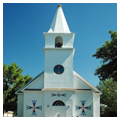You are here
St. Stephens Mission Church
The Wind River Indian Reservation occupies more than two million acres in central Wyoming. St. Stephens, located in the southeastern part of the reservation just south of Riverton, is one of three missions established on the reservation in the late nineteenth century. A Catholic mission at St. Stephens was originally established by Father John J. Jutz, a Jesuit priest, who built a four-room mission house on land selected by the Arapaho chief Black Coal in 1884. Soon additional buildings were added for a convent and a boarding school for Indian children in grades one through 8, including a three-story brick convent (1888), a boys’ dormitory (1892) and a girls’ dormitory (1894). In 1928 a fire destroyed the mission church and the boys' dorm, but the buildings were reconstructed the same year.
The church is a simple rectangular building with a front entry topped by a square tower rising to a steeple. Its stuccoed exterior is painted white and decorated with traditional Arapaho designs and symbols on the front and side walls. The designs were created by Raphael Norse, an Arapaho artist, in 1970, and fill the spaces between the windows on both side elevations of the church. Norse also designed the decorations flanking and above the doorway.
The decorative motif is carried into the interior, which features pressed tin ceiling tiles painted in a bright, geometric pattern and murals on either side of the altar. The interior is an interesting mixture of Roman Catholic and American Indian symbols, with the baptismal font and altar in the shape of drums, a lectern in the shape of a thunderbird, and a crucifix composed of poles arranged like those of a tipi. The murals and the fourteen stained glass windows that light the church were designed and crafted by local Arapaho artists in the 1990s. A central aisle with pews on either side leads from the entrance to the altar.
Also existing on the site is the former boys’ dormitory and school (1928) that now serves as a post office, community center, museum, and gift shop; Sister Incarnata Hall, a two-story, Italianate brick building with a low hipped roof that is used for various parish and school events; and a gymnasium/auditorium/classroom building added in 1954. These buildings represent the U.S. government’s early attempts to educate tribal children in Euro-American culture by establishing boarding schools. On the Wind River Indian Reservation, the task was given over to the Episcopal church, which established a school at Fort Washakie, and the Catholic Church, which established mission schools in Ethete as well as St. Stephens.
St. Stephens operated as a boarding school until it was converted to a day school in 1939. In 1975, the mission administration ceased operations due to lack of funds, and control of the facility was transferred to the St. Stephens Indian School Educational Association, a local American Indian corporation. The current St. Stephens Indian School, a K-12 facility supported by the Bureau of Indian Affairs, is located across the street from the St. Stephens Church. The church, museum/gift shop, and grounds are open to visitors.
References
Fraser, Clayton B, Mary Humstone, and Rheba Massey. Places of Learning: Historical Context of Schools in Wyoming. Cheyenne: Wyoming State Historic Preservation Office, 2010. http://wyoshpo.state.wy.us/pdf/WyomingSchoolsContext.pdf.
Histories of St. Stephens Mission Church. Compiled by the Diocese of Cheyenne. .
Address
Writing Credits
If SAH Archipedia has been useful to you, please consider supporting it.
SAH Archipedia tells the story of the United States through its buildings, landscapes, and cities. This freely available resource empowers the public with authoritative knowledge that deepens their understanding and appreciation of the built environment. But the Society of Architectural Historians, which created SAH Archipedia with University of Virginia Press, needs your support to maintain the high-caliber research, writing, photography, cartography, editing, design, and programming that make SAH Archipedia a trusted online resource available to all who value the history of place, heritage tourism, and learning.

























